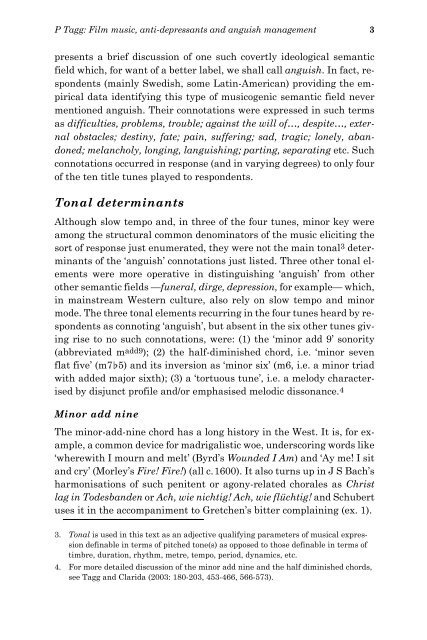Film music, antidepressants and anguish management - Philip Tagg
Film music, antidepressants and anguish management - Philip Tagg
Film music, antidepressants and anguish management - Philip Tagg
You also want an ePaper? Increase the reach of your titles
YUMPU automatically turns print PDFs into web optimized ePapers that Google loves.
P <strong>Tagg</strong>: <strong>Film</strong> <strong>music</strong>, anti-depressants <strong>and</strong> <strong>anguish</strong> <strong>management</strong> 3<br />
presents a brief discussion of one such covertly ideological semantic<br />
field which, for want of a better label, we shall call <strong>anguish</strong>. In fact, respondents<br />
(mainly Swedish, some Latin-American) providing the empirical<br />
data identifying this type of <strong>music</strong>ogenic semantic field never<br />
mentioned <strong>anguish</strong>. Their connotations were expressed in such terms<br />
as difficulties, problems, trouble; against the will of…, despite…, external<br />
obstacles; destiny, fate; pain, suffering; sad, tragic; lonely, ab<strong>and</strong>oned;<br />
melancholy, longing, l<strong>anguish</strong>ing; parting, separating etc. Such<br />
connotations occurred in response (<strong>and</strong> in varying degrees) to only four<br />
of the ten title tunes played to respondents.<br />
Tonal determinants<br />
Although slow tempo <strong>and</strong>, in three of the four tunes, minor key were<br />
among the structural common denominators of the <strong>music</strong> eliciting the<br />
sort of response just enumerated, they were not the main tonal 3 determinants<br />
of the ‘<strong>anguish</strong>’ connotations just listed. Three other tonal elements<br />
were more operative in distinguishing ‘<strong>anguish</strong>’ from other<br />
other semantic fields —funeral, dirge, depression, for example— which,<br />
in mainstream Western culture, also rely on slow tempo <strong>and</strong> minor<br />
mode. The three tonal elements recurring in the four tunes heard by respondents<br />
as connoting ‘<strong>anguish</strong>’, but absent in the six other tunes giving<br />
rise to no such connotations, were: (1) the ‘minor add 9’ sonority<br />
(abbreviated m add9); (2) the half-diminished chord, i.e. ‘minor seven<br />
flat five’ (m7$5) <strong>and</strong> its inversion as ‘minor six’ (m6, i.e. a minor triad<br />
with added major sixth); (3) a ‘tortuous tune’, i.e. a melody characterised<br />
by disjunct profile <strong>and</strong>/or emphasised melodic dissonance.4<br />
Minor add nine<br />
The minor-add-nine chord has a long history in the West. It is, for example,<br />
a common device for madrigalistic woe, underscoring words like<br />
‘wherewith I mourn <strong>and</strong> melt’ (Byrd’s Wounded I Am) <strong>and</strong> ‘Ay me! I sit<br />
<strong>and</strong> cry’ (Morley’s Fire! Fire!) (all c.1600). It also turns up in J S Bach’s<br />
harmonisations of such penitent or agony-related chorales as Christ<br />
lag in Todesb<strong>and</strong>en or Ach, wie nichtig! Ach, wie flüchtig! <strong>and</strong> Schubert<br />
uses it in the accompaniment to Gretchen’s bitter complaining (ex. 1).<br />
3. Tonal is used in this text as an adjective qualifying parameters of <strong>music</strong>al expression<br />
definable in terms of pitched tone(s) as opposed to those definable in terms of<br />
timbre, duration, rhythm, metre, tempo, period, dynamics, etc.<br />
4. For more detailed discussion of the minor add nine <strong>and</strong> the half diminished chords,<br />
see <strong>Tagg</strong> <strong>and</strong> Clarida (2003: 180-203, 453-466, 566-573).














